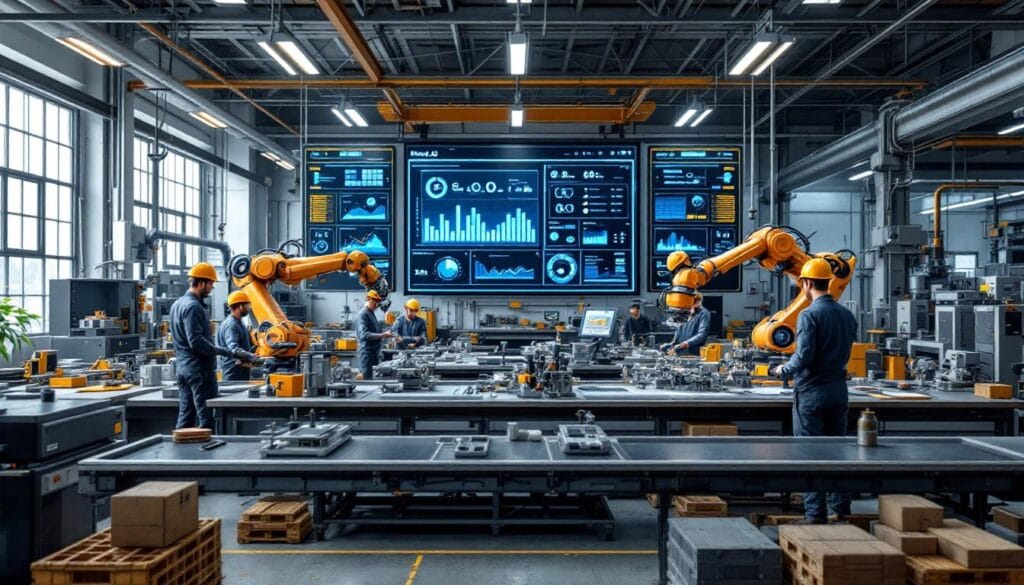The revolution of Industry 4.0 is accelerating at an unprecedented pace.Technological advancements are redefining global supply chains.Companies are transforming to remain competitive in a globalized market.
The Industry 4.0 market has reached an impressive size of $164.7 billion in 2024. According to forecasts, it is expected to soar to $570.5 billion by 2033, with a compound annual growth rate of 14.44%. This growth is primarily driven by massive adoption of the Internet of Things (IoT) and smart manufacturing, the increasing importance of data analytics, and government initiatives. The detailed analysis of the market includes the industry size, business trends, market shares, and key growth drivers. It provides a comprehensive overview integrating research findings, market assessments, and data from various sources. Furthermore, market dynamics such as growth drivers and challenges are examined, highlighting growth opportunities, financial prospects, technological improvements, emerging trends, and innovations.
The increased adoption of IoT and smart manufacturing is a key factor in this rapid expansion. With over 18.8 billion connected IoT devices in 2023 and an estimate exceeding 25.44 billion by 2030, smart factories are using integral information to automate processes efficiently. For example, IoT sensors monitor machines, thereby reducing maintenance downtime and increasing production efficiency. This type of automated systems minimizes errors, optimizes resource management, and enhances supply chain visibility, resulting in substantial savings and increased product loyalty. Companies must adopt agile production processes to respond flexibly to changing customer needs, as demonstrated by IoT-integrated assembly lines implemented by industry leaders like BMW.
Data analytics also plays a major role in Industry 4.0. Smart factories cannot operate efficiently without strategic management of the data collected by sensor-equipped machines. This analytics allows for predicting failures, improving product quality, and optimizing resource management. Platforms like General Electric’s reduce downtime in manufacturing operations through advanced analytics. The growth of the global data and analytics market, with an annual growth rate of 26.2%, reflects the crucial importance of these technologies in streamlining resource management, reducing waste, and promoting sustainable practices.
Government-driven initiatives and partnerships are also critical for the growth of the Industry 4.0 market. Programs such as the smart manufacturing project by the U.S. Department of Energy and the SAMARTH Udyog Bharat 4.0 initiative in India promote innovation and the adoption of advanced technologies. These initiatives offer funding, tax incentives, and collaborative opportunities, thus facilitating the adoption of expensive technologies even for small businesses. Companies like Bosch collaborate with governmental initiatives to enhance AI-based manufacturing, thereby boosting competitiveness and supporting sustainable growth.
Major companies operating in the Industry 4.0 sector include tech giants like Cisco Systems Inc., Intel Corporation, IBM, and Siemens. These companies invest heavily in developing innovative solutions to meet the growing market needs. The sector is also segmented into different categories, including hardware, software, and services, as well as by technology type such as industrial robotics, industrial IoT, artificial intelligence and machine learning, blockchain, extended reality, digital twins, and 3D printing.
The geographical distribution of the market shows a dominance of Europe, thanks to increasing investments in IoT and automation, along with government policies favoring digital transformation. Asia-Pacific follows closely, with countries like China, Japan, and India leading in the adoption of Industry 4.0 technologies.
The market report uses a comprehensive research methodology, combining primary and secondary data sources to validate the findings. This approach ensures the accuracy and reliability of the information, integrating market assessments, surveys, expert opinions, and data triangulation techniques.

“`html
Table des matières
Togglethe rapid growth of the Industry 4.0 market
The era of Industry 4.0 is radically transforming the global manufacturing landscape. According to a recent study by IMARC Group, the global market size of Industry 4.0 reached $164.7 billion in 2024. This exponential expansion is driven by various factors, including increased adoption of the Internet of Things (IoT), the rise of smart manufacturing, data analytics, and government initiatives. The projection for 2033 indicates that the market will reach $570.5 billion, with an annual growth rate of 14.44%.
what are the key factors driving this growth?
Several elements catalyze the rapid expansion of Industry 4.0. Among them, the merger of IoT and smart manufacturing are essential drivers. In 2023, the number of connected IoT devices worldwide exceeded 18.8 billion, a figure projected to surpass 25.44 billion by 2030. IoT sensors enable smart factories to collect real-time data, thus facilitating automation and optimization of production processes. Companies like Siemens use these technologies to reduce maintenance downtime, consequently increasing production capabilities.
Another key factor is data analytics, which plays a central role in Industry 4.0. Advanced analytics allow companies to predict failures before they occur, thus improving product quality and operational efficiency. The Predix platform of General Electric, for example, uses analytics algorithms to minimize production downtimes, thereby increasing productivity. According to the study, the global market for data and advanced analytics is expected to grow at an annual rate of 26.2% between 2024 and 2032.
Finally, government initiatives and public-private partnerships play a decisive role. Programs like the SAMARTH Udyog Bharat 4.0 initiative in India and substantial investments from the U.S. Department of Energy in smart manufacturing projects reflect the commitment of governments to support digital transformation. These initiatives provide tax incentives, funding, and collaborative opportunities, encouraging the adoption of costly technologies even by the smallest businesses.
how technological innovations stimulate Industry 4.0?
Technological innovation is at the heart of the expansion of Industry 4.0. Advances in fields such as industrial robotics, Artificial Intelligence (AI), blockchain, and 3D printing are revolutionizing how businesses operate. Industrial IoT dominates the market due to its ability to enhance connectivity and data collection. Moreover, the Digital Twin, a digital representation of physical objects, allows for accurate simulation of production processes, facilitating optimization and predictive maintenance.
The adoption of AI and machine learning enables in-depth analysis of the collected data, leading to data-driven decisions. Companies like Nokia are driving Industry 4.0 with innovative applications such as MX Industrial Edge, which integrate AI to enhance field operations. These technologies not only increase efficiency but also allow for rapid responses to changing customer needs and maintain competitiveness in an ever-evolving market.
what is the regional distribution of the Industry 4.0 market?
The global Industry 4.0 market is diverse, with a strong presence in several key regions. Europe currently dominates the market due to increasing investments in IoT and automation, supported by government policies favoring digital transformation. North America follows closely, with rapid adoption of advanced technologies by manufacturing industries and robust infrastructure.
The Asia-Pacific region is also emerging as a major player, driven by massive investments in China, Japan, South Korea, and India. Initiatives such as the revolution of Industry 4.0 in Latin America demonstrate the expansion of Industry 4.0 technologies even in emerging markets. Additionally, the Middle East and Africa are experiencing gradual adoption, driven by industrial development projects and strategic partnerships.
Each region presents unique dynamics. For instance, Latin America benefits from innovative government programs that encourage the adoption of cutting-edge technologies. Moreover, in Europe, the focus on sustainability and green initiatives fuels the integration of Industry 4.0 solutions, thereby creating an environment conducive to continuous market growth.
who are the key players in the Industry 4.0 market?
The global Industry 4.0 market is dominated by several major players who continuously innovate to maintain their leadership position. Among the most influential companies are Cisco Systems Inc., DENSO Corporation, Fanuc Corporation, Hewlett Packard Enterprise Company, Intel Corporation, International Business Machines Corporation (IBM), Nvidia Corporation, Robert Bosch GmbH, SAP SE, Schneider Electric SE, and Stratasys Ltd..
These companies stand out for their ability to integrate advanced technologies such as AI, industrial IoT, and smart robots into their product and service offerings. For example, Robert Bosch GmbH has established strategic partnerships with German initiatives to enhance AI-based manufacturing, while Capgemini has distinguished itself as a leader in the PEAK Matrix 2025 evaluation of Industry 4.0 services, according to Everest Group.
Additionally, Nokia is driving Industry 4.0 with new applications, including MX Industrial Edge, which incorporate artificial intelligence to improve industrial operations. The diversity of product portfolios and the emphasis on technological innovation allow these companies to stay at the forefront of digital transformation in the manufacturing sector.
what are the trends and future outlooks for Industry 4.0?
The future of Industry 4.0 is marked by continuous innovations and the integration of emerging technologies. One of the main trends is the increased adoption of blockchain to enhance security and transparency in the supply chain. Furthermore, digital twin technology enables precise simulation of production processes, facilitating optimization and predictive maintenance.
The rise of big data and advanced analytics will continue to transform industrial operations, allowing for more informed and proactive decision-making. Additionally, extended reality (XR), encompassing augmented reality and virtual reality, offers new ways to interact with production systems, improving training and operator efficiency.
Academic initiatives such as the launch of the Industry 4.0 Academy by NCPA and Penn State Dubois illustrate the importance of training and research in the future development of Industry 4.0. These academic collaborations aim to train the next generation of professionals capable of driving digital transformation and continuously innovating in the sector.
Moreover, the growing emphasis on sustainability and eco-friendly practices is influencing how Industry 4.0 technologies are deployed, promoting energy-efficient solutions and greener operations. As companies seek to meet regulatory requirements and consumer expectations, the integration of Industry 4.0 will become even more crucial to remain competitive.
how are the Industry 4.0 market segments distributed?
The Industry 4.0 market is divided into several key segments, each essential for its own contribution to the overall ecosystem. In terms of components, the market is segmented into hardware, software, and services. The hardware encompasses IoT devices, sensors, and robotic equipment, while the software includes analytics platforms and industrial management systems. The services cover system integration, technical support, and consulting services.
Regarding technologies, Industry 4.0 is segmented into industrial robotics, industrial IoT, AI and ML, blockchain, extended reality, digital twin, 3D printing, and other emerging technologies. The industrial IoT sector holds a dominant share of the market due to its critical role in enhancing connectivity and data collection.
In terms of regions, Industry 4.0 is mainly distributed across North America (United States, Canada), Asia-Pacific (China, Japan, India, South Korea, Australia, Indonesia, others), Europe (Germany, France, United Kingdom, Italy, Spain, Russia, others), Latin America (Brazil, Mexico, others), and Middle East and Africa. Each region presents unique dynamics influencing the growth and adoption of Industry 4.0 technologies.
why are data and analytics crucial for Industry 4.0?
Data and analytics play a hegemonic role in the rise of Industry 4.0. Machines equipped with sensors collect vast amounts of real-time data, allowing for continuous monitoring and proactive optimization of production processes. For example, the Predix platform from General Electric uses advanced analytics to reduce downtime in manufacturing activities, thereby increasing efficiency and productivity.
Data analytics also helps anticipate potential failures, improving product quality and reducing waste. This ability to foresee failures before they occur leads to significant savings and improved product loyalty. Additionally, data analytics provides enhanced visibility across the supply chain, allowing for more efficient resource management and better decision-making based on solid trends and forecasts.
Sectors such as aerospace and electronics particularly benefit from data analytics, increasing supply chain efficiency and fostering data-driven decisions. By emphasizing operational efficiencies and resilience, companies accelerate the adoption of advanced analytics technologies, thus opening enormous opportunities for growth and innovation across various sectors.
how do government initiatives promote Industry 4.0?
Government initiatives and partnerships play a vital role in the development and adoption of Industry 4.0. These initiatives promote innovation and facilitate the adoption of advanced technologies by offering funding, tax incentives, and collaborative opportunities. For example, the U.S. Department of Energy has invested $33 million in smart manufacturing projects, demonstrating the public sector’s commitment to supporting digital transformation.
The SAMARTH Udyog Bharat 4.0 initiative in India aims to integrate Industry 4.0 technologies by 2025, encouraging businesses to modernize their production processes. Countries like Germany, Singapore, and China have also established similar programs, supporting the adoption of technologies such as IoT, AI, and cloud computing in the manufacturing sector.
These government programs even help smaller companies adopt expensive technologies by providing the necessary support to remain competitive and sustainable. Bosch, for example, collaborates with German initiatives to strengthen AI-based manufacturing, which enhances competitiveness and supports sustainable economic growth. As governments prioritize digital transformation, the Industry 4.0 market continues to expand, solidifying its position as a cornerstone of modern industry.
what is the integration of Industry 4.0 across various sectors?
Industry 4.0 is not limited to the traditional manufacturing sector; it also extends to other areas such as construction, where its adoption transforms work methods and enhances efficiency. In the construction sector, the integration of technologies such as autonomous robots, IoT sensors, and AI-based applications streamlines processes, reduces costs, and improves worker safety. According to a recent study, the integration of Industry 4.0 in the construction sector shows a variable level of preparedness, but with enormous potential for long-term innovation and efficiency.
Construction companies are adopting advanced solutions such as drones for site monitoring and digital twins for planning and predictive maintenance. These technologies enable better resource management, reduce project timelines, and enhance the overall quality of construction. The application of Industry 4.0 in construction also contributes to sustainability by optimizing material usage and minimizing waste, thereby aligning economic goals with modern environmental requirements.
why are data and analytics crucial for Industry 4.0?
Data and analytics play a hegemonic role in the rise of Industry 4.0. Machines equipped with sensors collect vast amounts of real-time data, allowing for continuous monitoring and proactive optimization of production processes. For example, the Predix platform from General Electric uses advanced analytics to reduce downtime in manufacturing activities, thereby increasing efficiency and productivity.
Data analytics also helps anticipate potential failures, improving product quality and reducing waste. This ability to foresee failures before they occur leads to significant savings and improved product loyalty. Additionally, data analytics provides enhanced visibility across the supply chain, allowing for more efficient resource management and better decision-making based on solid trends and forecasts.
Sectors such as aerospace and electronics particularly benefit from data analytics, increasing supply chain efficiency and fostering data-driven decisions. By emphasizing operational efficiencies and resilience, companies accelerate the adoption of advanced analytics technologies, thus opening enormous opportunities for growth and innovation across various sectors.
how do government initiatives promote Industry 4.0?
Government initiatives and partnerships play a vital role in the development and adoption of Industry 4.0. These initiatives promote innovation and facilitate the adoption of advanced technologies by offering funding, tax incentives, and collaborative opportunities. For example, the U.S. Department of Energy has invested $33 million in smart manufacturing projects, demonstrating the public sector’s commitment to supporting digital transformation.
The SAMARTH Udyog Bharat 4.0 initiative in India aims to integrate Industry 4.0 technologies by 2025, encouraging businesses to modernize their production processes. Countries like Germany, Singapore, and China have also established similar programs, supporting the adoption of technologies such as IoT, AI, and cloud computing in the manufacturing sector.
These government programs even help smaller companies adopt expensive technologies by providing the necessary support to remain competitive and sustainable. Bosch, for example, collaborates with German initiatives to strengthen AI-based manufacturing, which enhances competitiveness and supports sustainable economic growth. As governments prioritize digital transformation, the Industry 4.0 market continues to expand, solidifying its position as a cornerstone of modern industry.




